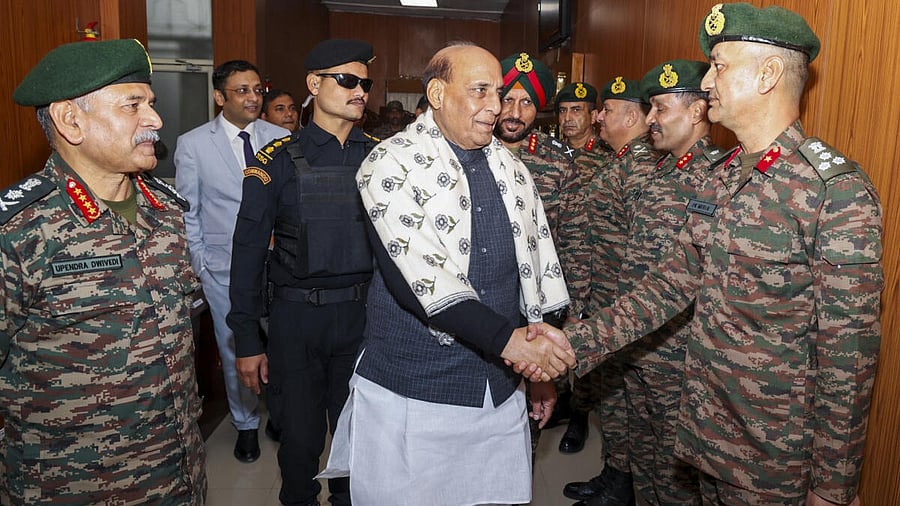
Defence Minister Rajnath Singh with Chief of Army Staff (COAS) General Upendra Dwivedi and others.
Credit: PTI Photo
New Delhi: With technology shaping the courses of wars around the world, the Defence Ministry on Wednesday said 2025 would be marked as the year of reforms in which the armed forces will embrace cyber, space and emerging technologies in a big way and steps will be taken to facilitate setting up 'integrated theatre commands'.
While the three services would have to develop a “shared understanding” of operational needs, the reforms would bolster “jointness and integration” initiatives, a defence ministry spokesperson said in a statement, noting that thrust would also be given on “breaking the silos” to involve other partners in the defence eco-system to optimise the resources.
A nine-point guideline was issued after Defence Minister Rajnath Singh held a review meeting with all the Secretaries in the ministry to review the progress on various schemes, projects, reforms and the way ahead.
On the long-awaited theatre commands, the ministry stopped short of saying when the new command structure will be unveiled, but noted that “reforms should aim to further bolster jointness and integration initiatives and facilitate establishment of the Integrated Theatre Commands.”
India currently has 19 operational commands, out of which 17 are distributed between the Army, Navy and IAF. The remaining two are tri-service Andaman and Nicobar Command and Strategic Forces Command under the Integrated Defence Staff.
Over the last five years, an effort is on to integrate these service-specific commands into a few integrated theatre commands, each having the elements of army, air force and navy depending on the nature of the theatre.
The task – considered one of the biggest military reforms – was undertaken by the first Chief of the Defence Staff Gen Bipin Rawat and is being carried forward by his successor Gen Anil Chauhan, who is building consensus among the services to support the move.
Rajnath said the reforms would lay the foundation for "unprecedented" advancements in defence preparedness and transform the armed forces into “a technologically-advanced combat-ready force capable of multi-domain integrated operations.”
On the technology front, the reforms will focus on cyber, space, and emerging technologies like artificial intelligence, machine learning, hypersonics and robotics. Also associated tactics, techniques and procedures to win future wars will be developed.
The two ongoing wars in Europe and West Asia have revealed to the world the role technologies can play in deciding the course of action on the battlefield. This has led to a renewed emphasis among the armed forces to induct such technologies in order to stay ahead of the enemies.
The acquisition procedures will be made simpler and time-sensitive to facilitate swifter and robust capability development. Also the reforms will seek to position India as a credible exporter of defence products and a partner for foreign firms for collaboration.
The meeting led by Singh held that reforms should facilitate technology transfer and knowledge-sharing between the defence sector and civil industries besides promoting public-private partnerships. Also, the expertise of the veterans are to be leveraged.
Moreover, a sense of pride in Indian culture and tradition is to be instilled while imbibing the best practices from the modern military.
